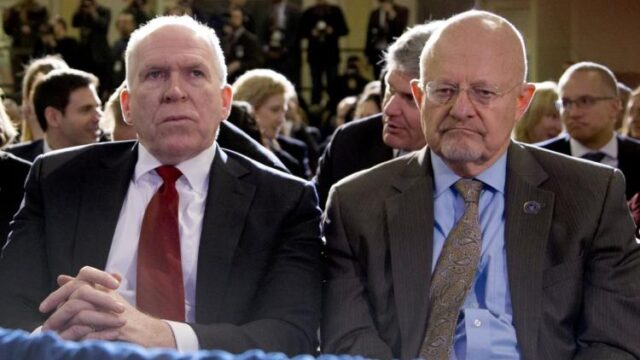Explosive New CIA Report Details Russiagate Fraud

Miranda Devine of the New York Post, who broke the fateful story about Hunter Biden’s laptop, has struck again with an exposé on the origins of Russiagate that implicates former intelligence chiefs John Brennan, James Comey, and Jim Clapper in an elaborate fraud. From the story, which is centered on a new CIA report commissioned by John Ratcliffe:
Brennan handpicked the CIA analysts to compile the ICA and involved only the ODNI, CIA, FBI and NSA, excluding 13 of the then-17 intelligence agencies.
He sidelined the National Intelligence Council and forced the inclusion of the discredited Steele dossier despite objections of the authors and senior CIA Russia experts, so as to push a false narrative that Russia secured Trump’s 2016 victory.
“This was Obama, Comey, Clapper and Brennan deciding ‘We’re going to screw Trump,’” said Ratcliffe in an exclusive interview. “It was, ‘We’re going to create this and put the imprimatur of an IC assessment in a way that nobody can question it.’”
The CIA report is focused mainly on the publication of the infamous Intelligence Community Assessment of January 6th, 2017, which concluded that Russian President Vladimir Putin sought “to undermine public faith in the US democratic process, denigrate Secretary Clinton, and harm her electability” while maintaining a “clear preference for President-elect Trump.” Publication of that Intelligence Assessment, which was ordered by Barack Obama on December 6th, 2016 and included material from the infamous Steele dossier, set in motion a series of events that led to Special Counsel Robert Mueller’s investigation. It was the trigger for years of Russiagate lunacy that consumed Trump’s first term.
Racket readers may remember reports I co-authored with Michael Shellenberger and Alexandra Gutentag last February, describing how Brennan, Comey, and Clapper “cooked the intelligence” in that 2017 ICA. For instance, the chiefs suppressed junior analysts’ belief that Russia may not have preferred Trump, seeing him as “mercurial,” “unreliable,” and “not steady,” while viewing a possible Clinton presidency as “manageable and reflecting continuity.” The notion that the ICA was manipulated isn’t new, as Aaron Mate at RealClearInvestigations reported the ICA’s preparation “deviated from standard CIA practice,” and similar reports came out via former CIA analyst Ray McGovern, current deputy FBI director Dan Bongino, and others.
However, this new report contains a wealth of new details. It’s not clear what this may or may not mean for any possible future criminal investigation, but Ratcliffe’s CIA investigation fills in a lot of blanks. Some key conclusions:
CIA chief was warned not to include the Steele Dossier
The new CIA report criticizes the intel chiefs for including the Steele Dossier in the report, saying that “ran counter to fundamental tradecraft principles” and “undermined the credibility” of his key conclusions. That isn’t just a post-factum conclusion, however. The report reveals:
CIA’s Deputy Director for Analysis (DDA) warned in an email to Brennan on 29 December that including it in any form risked “the credibility of the entire paper.”
Thanks to previous reports (including material from John Brennan’s own book Undaunted), it was already known that Brennan not only overruled NSA chief Mike Rogers but “two senior managers for the CIA mission center for Russia” to reach the much-disputed conclusion that Putin “aspired” to help Donald Trump win the election. The new CIA report’s inclusion of an email from a senior CIA official specifically warning against use of the Steele Dossier is damning.
Regarding the objections of those two “senior managers,” Ratcliffe had more detail:
The two senior leaders of the CIA mission center responsible for Russia argued jointly against including the “aspire” judgment. In an email to Brennan on 30 December, they stated the judgment should be removed because it was both weakly supported and unnecessary, given the strength and logic of the paper’s other findings on intent. They warned that including it would only “open up a line of very politicized inquiry.”
It’s one thing for Ratcliffe to criticize the ICA, but these specific email warnings add significantly to the pile of evidence that the key pillar of Russiagate was manipulated.
NSA considered “alternative” conclusion
Without an Intelligence Assessment saying Russia hoped to harm Hillary Clinton’s chances and help Trump, the American public likely wouldn’t have gone through years of Russiagate scandal. The three agencies that put the ICA together — the CIA, FBI, and NSA — all started out with differing views on that key question of whether or not Russia specifically wanted to help Trump. Of the three agencies, the NSA and its chief Mike Rogers were the least enthusiastic about endorsing that conclusion. From the new report:
NSA and a few other participants were not comfortable with ascribing “high confidence” to the “aspired” judgment. They cited the limited source base, lack of corroborating intelligence, and “the possibility for an alternative judgment” as driving their discomfort.
It was bad enough that the NSA would only say publicly it had “moderate” confidence in the ICA. As the Ratcliffe report explains, “moderate confidence generally means that the information is credibly sourced and plausible but not… corroborated sufficiently.” Moderate was “equivalent to no,” as one source told me last year.
That the NSA believed there was room from the available intelligence to come up with an “alternative judgment” undermines the ICA conclusion even more.
Why the FBI endorsed the ICA
According to the report:
FBI leadership made it clear that their participation in the ICA hinged on the Dossier’s inclusion and, over the next few days, repeatedly pushed to weave references to it throughout the main body of the ICA.
This is a significant revelation, because while the NSA expressed only “moderate” confidence in the Intelligence Assessment, the FBI appeared to change its mind.
On October 31, 2016, a week before Obama ordered the ICA written, senior FBI officials told the New York Times in a much-criticized piece called “Investigating Donald Trump, F.B.I. Sees No Clear Link to Russia” that “even the hacking into Democratic emails, F.B.I. and intelligence officials now believe, was aimed at disrupting the presidential election rather than electing Mr. Trump.” In the first week of December 2016, the FBI and CIA reportedly gave conflicting briefings to Congress on the question. Shortly after, the FBI publicly backed the CIA’s interpretation.
The reason for the FBI’s turnaround has always been a mystery. If the FBI’s participation in the Intelligence Community Assessment was contingent on the CIA publicly backing the Steele Dossier, it might answer that question. The FBI by December 2016 already knew it had an issue with its use of the Steele Dossier to obtain FISA surveillance on Carter Page, and the FBI’s lead Trump-Russia investigator Peter Strzok had privately questioned Steele’s reliability. By inducing the CIA to throw its weight behind the flawed document (one the CIA itself had pooh-poohed as “internet rumor”), the FBI and Comey gained crucial bureaucratic cover.
It was Brennan all along
From the report:
One business day before IC analysts convened for the only coordination session on the ICA, Brennan sent a note to the CIA workforce stating he had met with the DNI and FBI Director and that “there is strong consensus among us on the scope, nature, and intent of Russian interference in our recent Presidential election.” While officers involved in drafting the ICA consistently said they did not feel pressured …Brennan’s premature signaling… risked stifling analytic debate.
As has been made clear, there was no “strong consensus” about Russia’s intentions among the three agencies. The NSA was lukewarm at best, the FBI gave public statements contradicting the ICA conclusions, and even within the CIA — even within Brennan’s hand-picked group of CIA analysts — there was serious dissent. Brennan steamrolled that dissent in a number of ways, beginning with this “premature signaling” effort, and moving on to override his own team.
Ratcliffe wrote that “Brennan showed a preference for narrative consistency over analytical soundness,” describing a scene in which he overrode the objections to the Steele Dossier by those two CIA “mission center for Russia” analysts. When confronted, Brennan reportedly said, “My bottom line is that I believe that the information warrants inclusion in the report.”
Overall, the report looks very bad for the intelligence chiefs Brennan, Comey, and Clapper, who submitted the flawed ICA to the National Intelligence Council just “hours before it was due to be published,” as Devine wrote. Those same figures then briefed President-Elect Trump about the ICA’s contents, ostensibly to warn him about the possibility of Russian efforts to compromise him. Shortly after, the details of that briefing were leaked to the press. In this manner, the otherwise classified issue of “blackmail” and the pee tape and so on became public, leading to years of the Russiagate circus.
Much like the WMD episode, where it later came out that analysts who worked on a National Intelligence Assessment about Iraq had wildly differing beliefs about whether or not Saddam Hussein was pursuing a weapon of mass destruction, Russiagate and the 2017 ICA now look like an episode that will be infamous because of the way dissenting opinions were suppressed. We’ll have more on what this report means as information comes in.
